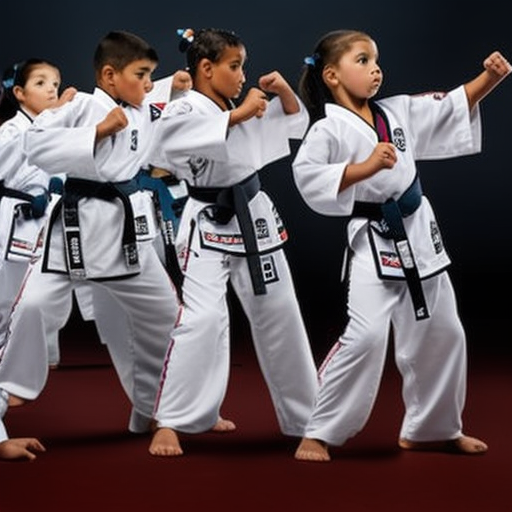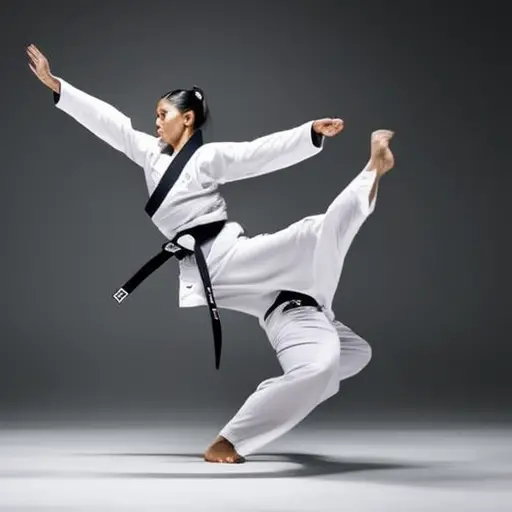Taekwondo for Children: What Parents Should Know

Prepare your child for a journey of discipline, respect, and physical fitness with Taekwondo.
In this informative article, we will enlighten parents on what they should know about Taekwondo for children.
Discover the numerous benefits, safety measures, age and skill requirements, and how Taekwondo instills discipline and respect in young minds.
Set realistic goals, find reputable instructors, and support your child’s progress in their Taekwondo practice.
Equip yourself with the knowledge to guide your child towards a well-rounded development.
The Benefits of Taekwondo for Children
One of the key benefits of taekwondo for children is that it helps them develop discipline and self-confidence. Taekwondo training instills a sense of discipline in children from a young age. Through the structured routines and rigorous training, children learn the importance of following rules, respecting authority, and maintaining focus. This discipline carries over into other areas of their lives, such as schoolwork, relationships, and future endeavors.
Moreover, taekwondo training also plays a crucial role in building self-confidence in children. As they progress through the ranks and master new techniques, children gain a sense of accomplishment and belief in their abilities. This newfound confidence extends beyond the training mats and empowers children to face challenges with resilience and determination.
In addition to discipline and self-confidence, taekwondo offers numerous other benefits for children. Physical fitness is a significant aspect of training, as it promotes overall health, strength, and flexibility. Taekwondo also teaches important life skills such as goal-setting, perseverance, and teamwork. The emphasis on respect and self-control fosters positive social behaviors and helps children develop strong moral values.
Age and Skill Requirements for Taekwondo Classes
When considering enrolling their child in taekwondo classes, parents should be aware of the age restrictions and required skills for participation.
Taekwondo schools typically have minimum age requirements to ensure that children have the physical and cognitive development necessary to participate safely and effectively.
Additionally, some schools may have specific requirements or expectations for certain skills or abilities before children can join certain class levels or participate in competitions.
Age Restrictions for Taekwondo
As parents consider enrolling their children in taekwondo classes, it is important to understand the age and skill requirements that may apply.
Age restrictions in taekwondo classes are typically determined by the specific martial arts school or organization. While some schools may accept children as young as four or five years old, others may require children to be at least six or seven.
This is because taekwondo involves physical movements and techniques that may be more suitable for older children who have developed better coordination and motor skills.
Additionally, class availability may vary based on age groups. Some schools may offer separate classes for different age ranges, ensuring that children are grouped with others of similar ages and skill levels.
It is always advisable to check with the taekwondo school or instructor to determine the specific age restrictions and class options available for your child.
Required Skills for Taekwondo?
To participate in taekwondo classes, children must possess certain skills and meet specific age requirements. Taekwondo is a martial art that requires discipline, focus, and physical fitness. Here are the required skills and training techniques for taekwondo:
-
Balance and coordination: Taekwondo involves various kicks, punches, and stances that require good balance and coordination. Children should be able to maintain their equilibrium while executing these techniques.
-
Flexibility: Taekwondo requires a high level of flexibility to perform kicks and other moves effectively. Regular stretching exercises can help children improve their flexibility over time.
-
Discipline and respect: Taekwondo emphasizes discipline and respect for oneself and others. Children should be able to follow instructions, show respect to their instructors and fellow students, and adhere to the rules and traditions of taekwondo.
Safety Measures in Taekwondo Training
When it comes to ensuring the safety of children during taekwondo training, there are several important measures to consider.
First and foremost, proper equipment such as headgear, mouthguards, and shin guards should be worn to prevent injuries.
Additionally, the presence of trained instructors who provide constant supervision and guidance is crucial, as they can intervene and correct any unsafe practices.
Lastly, using appropriate training techniques that are suitable for children’s age and skill level can help minimize the risk of accidents or injuries.
Equipment for Preventing Injuries
Implementing proper safety measures in Taekwondo training involves utilizing protective equipment to prevent injuries. By providing children with the necessary gear, parents can ensure their safety during training sessions.
Here are three essential pieces of equipment that can significantly reduce the risk of injuries:
-
Headgear: Designed to protect the head and face, headgear absorbs impact and minimizes the risk of concussions or facial injuries. It is crucial for children to wear properly fitted headgear to prevent any potential harm during sparring or contact drills.
-
Chest Protector: This protective gear covers the chest and abdomen, providing a layer of protection for vital organs. It absorbs and disperses impact, reducing the risk of internal injuries during sparring or kicking exercises.
-
Shin Guards: Shin guards are essential to protect the lower leg from injuries during blocking and kicking techniques. They offer padding and support, minimizing the risk of fractures or bruises.
Supervision During Training
Parents play a crucial role in ensuring the safety of their children during Taekwondo training. They can do this by providing constant supervision and implementing necessary safety measures. Supervision guidelines are essential to ensure that children are safe and well-protected during their training sessions.
Parents should always be present at the training venue, closely monitoring their child’s activities and interactions with other participants. They should actively engage with the instructors and ask questions about safety protocols and measures in place. This involvement in the training process is vital, as it allows for better communication and understanding between the instructors, parents, and children.
Appropriate Training Techniques
One must ensure that appropriate training techniques are used in Taekwondo to ensure the safety of children participating in the sport. By implementing these techniques, parents can help prevent injuries and promote skill development in their children.
Here are three important training techniques that parents should be aware of:
-
Warm-up exercises: Before engaging in any physical activity, it is crucial for children to warm up their muscles and joints. This helps prevent injuries and prepares their bodies for the training ahead.
-
Proper technique instruction: Taekwondo involves various kicks, punches, and strikes. It is important for children to learn the correct technique from a qualified instructor. This not only ensures their safety but also helps in developing their skills effectively.
-
Gradual progression: Children should be gradually introduced to more complex techniques and movements as they progress in their training. This allows their bodies to adapt and reduces the risk of overexertion or injury.
How Taekwondo Promotes Discipline and Respect in Children
Taekwondo instills a strong sense of discipline and respect in children, fostering their personal growth and character development. Through the practice of taekwondo, children learn valuable life skills that go beyond physical techniques. One of the key aspects of taekwondo is self-defense, which teaches children how to protect themselves and others in challenging situations. By learning various techniques and strategies, children develop confidence in their ability to defend themselves, promoting a sense of empowerment and self-assurance.
Additionally, taekwondo builds self-confidence in children. As they progress in their training and master new skills, children gain a sense of achievement and pride. The structured environment of taekwondo classes encourages children to set goals and work diligently to achieve them. This process not only enhances their physical abilities but also boosts their self-esteem and self-belief.
Furthermore, taekwondo teaches children the importance of discipline and respect. In taekwondo training, children are expected to follow strict rules and regulations, such as bowing to their instructors and fellow students, showing respect to higher belts, and adhering to the principles of taekwondo. This instills a sense of discipline and respect in children, helping them develop a strong moral compass and the ability to interact respectfully with others.
In summary, taekwondo promotes discipline and respect in children through teaching self-defense and building self-confidence. The practice of taekwondo instills valuable life skills that contribute to the personal growth and character development of children.
| Discipline | Respect | Personal Growth |
|---|---|---|
| Taekwondo training emphasizes discipline through strict rules and regulations | The practice of taekwondo teaches children to respect their instructors, fellow students, and higher belts | Taekwondo fosters personal growth by instilling confidence, self-belief, and a sense of achievement |
| Children learn to follow instructions and adhere to the principles of taekwondo | The importance of respecting others is emphasized through bowing and showing courtesy | Taekwondo helps children set goals and work diligently to achieve them, promoting personal growth |
| The structured environment of taekwondo classes promotes self-discipline | Children develop a strong moral compass and learn to interact respectfully with others | Taekwondo enhances physical abilities, boosting self-esteem and personal development |
| Taekwondo training instills a sense of responsibility and self-control | Children learn to value and respect the opinions and perspectives of others | Taekwondo fosters character development by teaching perseverance, resilience, and determination |
Physical Fitness and Taekwondo: What Parents Should Expect
With a combination of regular training and a focus on overall fitness, children can expect to see improvements in their physical health and strength through the practice of taekwondo. Taekwondo is a martial art that involves a variety of movements and techniques, which can greatly benefit a child’s physical development.
Here are some key aspects that parents should expect when it comes to physical fitness and taekwondo:
-
Improved cardiovascular endurance: Taekwondo training involves a lot of aerobic exercises, such as jumping, kicking, and sparring, which help to increase the heart rate and improve cardiovascular endurance.
-
Increased flexibility: Taekwondo requires a wide range of motions and kicks, which can help improve a child’s flexibility and joint mobility over time.
-
Enhanced strength and coordination: The various kicks, punches, and blocks in taekwondo help to build strength in the muscles, while the coordination required for executing these techniques improves balance and overall body control.
It is important to note that age and skill requirements may vary depending on the taekwondo school or organization. Some schools may have age restrictions for certain training programs or competitions to ensure the safety and appropriate development of children.
As we delve further into this topic, let’s explore the importance of finding a reputable taekwondo instructor for your child.
Finding a Reputable Taekwondo Instructor for Your Child
When searching for a reputable taekwondo instructor for your child, it is essential to consider their qualifications and experience. The reputation of taekwondo instructors is crucial in ensuring that your child receives quality training and guidance in this martial art. Here are some factors to consider when finding the right instructor:
| Qualifications | Experience |
|---|---|
| Certified black belt | Years of teaching experience |
| Instructor certification | Competition experience |
| CPR and first aid certification | Experience working with children |
A reputable taekwondo instructor should possess a certified black belt, indicating their proficiency in the art. Additionally, they should hold instructor certification, which demonstrates their knowledge of teaching methods and techniques. Experience is also vital, as it allows instructors to effectively communicate and connect with their students. Look for instructors who have several years of teaching experience and a track record of producing skilled taekwondo practitioners.
Moreover, an instructor who has competed in taekwondo tournaments can provide valuable insights and training techniques that will benefit your child. It is also important to ensure that the instructor is certified in CPR and first aid, as safety should be a top priority in any martial arts class.
Setting Realistic Goals in Taekwondo for Children
Parents should encourage their children to strive for progress and improvement in taekwondo, while also ensuring that the goals set are realistic and attainable. Realistic goal setting is essential for children in taekwondo as it helps them stay motivated and focused on their journey. Here are three key points to consider when setting realistic goals for children in taekwondo:
-
Assess the child’s abilities: It is important to have a clear understanding of the child’s current skill level and physical capabilities. Setting goals that are too challenging can lead to frustration, while setting goals that are too easy may hinder their progress. By assessing their abilities, parents can set goals that are challenging yet achievable.
-
Break down long-term goals: Taekwondo is a journey that requires time and dedication. Breaking down long-term goals into smaller, manageable milestones can help children stay motivated and track their progress. By focusing on smaller goals, children can experience a sense of accomplishment along the way, which will boost their confidence and keep them motivated.
-
Celebrate achievements: Celebrating achievements, no matter how small, is crucial in motivating children in taekwondo. Recognizing their efforts and progress will instill a sense of pride and encourage them to continue working towards their goals. Whether it is earning a new belt or mastering a new technique, acknowledging their achievements will motivate children to strive for further improvement.
Supporting Your Child’s Progress in Taekwondo
To ensure a well-rounded development, parents can actively participate in and guide their child’s progress in taekwondo by providing consistent support and guidance. One way to support your child’s progress is by ensuring they are learning age-appropriate techniques. Taekwondo is a martial art that emphasizes discipline and respect, and it is important for parents to ensure that their child is learning techniques and skills that are suitable for their age and physical abilities. This can be achieved by enrolling them in a reputable taekwondo school that has experienced instructors who understand how to tailor the training to different age groups.
Motivation and encouragement are also crucial factors in supporting your child’s progress in taekwondo. As a parent, you can play a significant role in keeping your child motivated by attending their training sessions, cheering them on during competitions, and celebrating their achievements. Encouragement can come in many forms, such as praising their efforts, reminding them of their progress, and providing constructive feedback. It is important to strike a balance between pushing your child to improve and respecting their individual pace and capabilities.
Frequently Asked Questions
What Are Some Common Injuries That Can Occur During Taekwondo Training and How Can Parents Prevent Them?
Common taekwondo training injuries include sprains, strains, and fractures. To prevent them, parents should ensure their children receive proper warm-up and stretching exercises, wear appropriate protective gear, and train under the supervision of qualified instructors.
Is It Necessary for Children to Have Prior Martial Arts Experience Before Starting Taekwondo Classes?
Prior martial arts experience is not necessary for children to start taekwondo classes. Taekwondo is designed to accommodate beginners and teach them the necessary skills and techniques. With proper instruction and guidance, children can excel in taekwondo without any prior martial arts experience.
How Can Taekwondo Help Children With Self-Confidence and Self-Esteem?
Taekwondo can be a valuable tool for enhancing children’s self-confidence and self-esteem. Through the practice of this martial art, children develop mental strength, discipline, and resilience, which in turn positively impacts their overall mental health and well-being.
Are There Any Specific Dietary Guidelines That Parents Should Follow for Their Children Who Are Participating in Taekwondo?
Taekwondo dietary guidelines are crucial for children participating in the sport. Nutrition plays a vital role in their training, providing the necessary energy, nutrients, and hydration. Parents should follow specific dietary guidelines to ensure their child’s optimal performance and overall health.
Can Taekwondo Training Have a Negative Impact on a Child’s Academic Performance or Social Life?
Taekwondo training can potentially have a negative impact on a child’s academic performance and social life. The rigorous physical demands and time commitment may lead to reduced study time and limited social interactions, affecting their overall well-being.
Conclusion
In conclusion, Taekwondo offers numerous benefits for children. These benefits include physical fitness, discipline, and respect. It provides a safe and structured environment for children to develop their skills and learn valuable life lessons. By finding a reputable instructor and setting realistic goals, parents can support their child’s progress in Taekwondo.
With dedication and perseverance, children can soar like confident eagles. Their bodies and minds will be honed to perfection through the art of Taekwondo.





